Produits
-
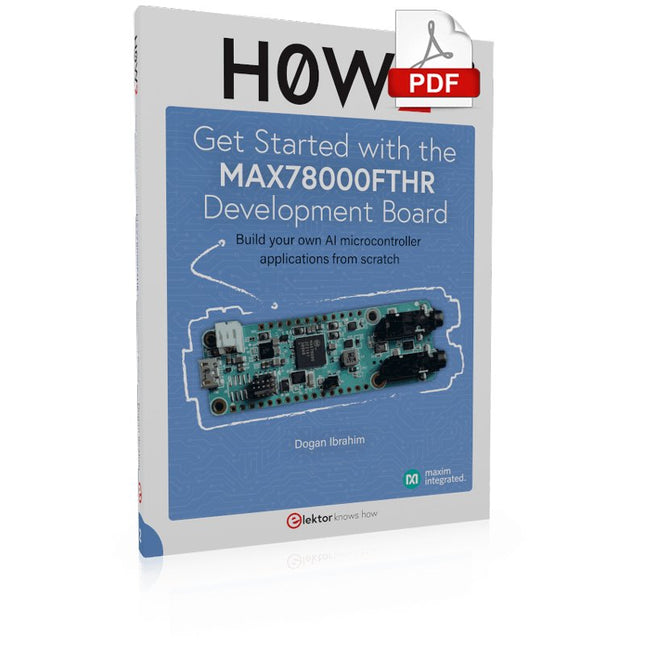
Elektor Digital H0W2: Get Started with the MAX78000FTHR Development Board (E-book)
Build your own AI microcontroller applications from scratch The MAX78000FTHR from Maxim Integrated is a small development board based on the MAX78000 MCU. The main usage of this board is in artificial intelligence applications (AI) which generally require large amounts of processing power and memory. It marries an Arm Cortex-M4 processor with a floating-point unit (FPU), convolutional neural network (CNN) accelerator, and RISC-V core into a single device. It is designed for ultra-low power consumption, making it ideal for many portable AI-based applications. This book is project-based and aims to teach the basic features of the MAX78000FTHR. It demonstrates how it can be used in various classical and AI-based projects. Each project is described in detail and complete program listings are provided. Readers should be able to use the projects as they are, or modify them to suit their applications. This book covers the following features of the MAX78000FTHR microcontroller development board: Onboard LEDs and buttons External LEDs and buttons Using analog-to-digital converters I²C projects SPI projects UART projects External interrupts and timer interrupts Using the onboard microphone Using the onboard camera Convolutional Neural Network
€ 32,95
Membres € 26,36
-

Elektor Publishing H0W2: Get Started with the SensorTile.box
STmicroelectronics’ wireless IoT & wearable sensor development kit ‘SensorTile.box’ is a portable multi-sensor circuit board housed in a plastic box and developed by STMicroelectronics. It is equipped with a high-performance 32-bit ARM Cortex-M4 processor with DSP and FPU, and various sensor modules, such as accelerometer, gyroscope, temperature sensor, humidity sensor, atmospheric pressure sensor, microphone, and so on. SensorTile.box is ready to use with wireless IoT and Bluetooth connectivity that can easily be used with an iOS or Android compatible smartphone, regardless of the level of expertise of the users. SensorTile.box is shipped with a long-life battery and all the user has to do is connect the battery to the circuit to start using the box. The SensorTile.box can be operated in three modes: Basic mode, Expert mode, and Pro mode. Basic mode is the easiest way of using the box since it is pre-loaded with demo apps and all the user has to do is choose the required apps and display or plot the measured data on a smartphone using an app called STE BLE Sensor. In Expert mode users can develop simple apps using a graphical wizard provided with the STE BLE Sensor. Pro mode is the most complex mode allowing users to develop programs and upload them to the SensorTile.box. This book is an introduction to the SensorTile.box and includes the following: Brief specifications of the SensorTile.box; description of how to install the STE BLE Sensor app on an iOS or Android compatible smartphone required to communicate with the box. Operation of the SensorTile.box in Basic mode is described in detail by going through all of the pre-loaded demo apps, explaining how to run these apps through a smartphone. An introduction to the Expert mode with many example apps developed and explained in detail enabling users to develop their own apps in this mode. Again, the STE BLE Sensor app is used on the smartphone to communicate with the SensorTile.box and to run the developed apps. The book then describes in detail how to upload the sensor data to the cloud. This is an important topic since it allows the sensor measurements to be accessed from anywhere with an Internet connection, at any time. Finally, Pro mode is described in detail where more experienced people can use the SensorTile.box to develop, debug, and test their own apps using the STM32 open development environment (STM32 ODE). The Chapter explains how to upload the developed firmware to the SensorTile.box using several methods. Additionally, the installation and use of the Unicleo-GUI package is described with reference to the SensorTile.box. This PC software package enables all of the SensorTile.box sensor measurements to be displayed or plotted in real time on the PC.
€ 34,95
Membres € 31,46
-
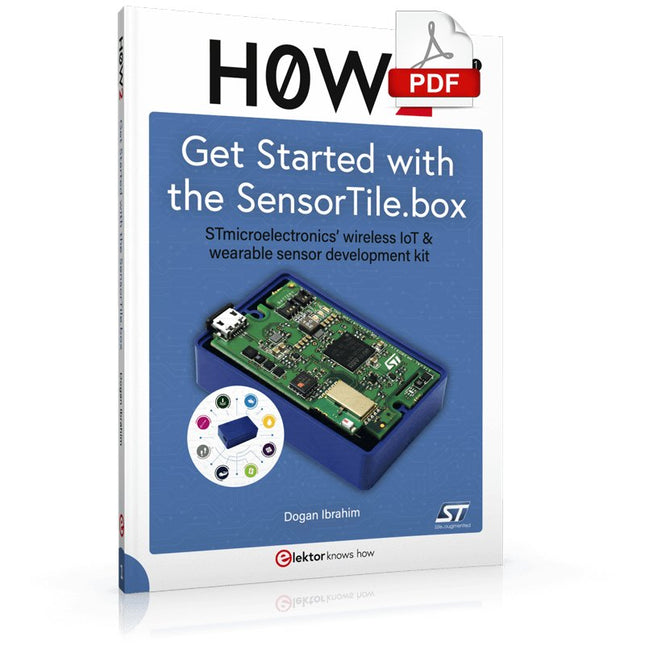
Elektor Digital H0W2: Get Started with the SensorTile.box (E-book)
STmicroelectronics’ wireless IoT & wearable sensor development kit ‘SensorTile.box’ is a portable multi-sensor circuit board housed in a plastic box and developed by STMicroelectronics. It is equipped with a high-performance 32-bit ARM Cortex-M4 processor with DSP and FPU, and various sensor modules, such as accelerometer, gyroscope, temperature sensor, humidity sensor, atmospheric pressure sensor, microphone, and so on. SensorTile.box is ready to use with wireless IoT and Bluetooth connectivity that can easily be used with an iOS or Android compatible smartphone, regardless of the level of expertise of the users. SensorTile.box is shipped with a long-life battery and all the user has to do is connect the battery to the circuit to start using the box. The SensorTile.box can be operated in three modes: Basic mode, Expert mode, and Pro mode. Basic mode is the easiest way of using the box since it is pre-loaded with demo apps and all the user has to do is choose the required apps and display or plot the measured data on a smartphone using an app called STE BLE Sensor. In Expert mode users can develop simple apps using a graphical wizard provided with the STE BLE Sensor. Pro mode is the most complex mode allowing users to develop programs and upload them to the SensorTile.box. This book is an introduction to the SensorTile.box and includes the following: Brief specifications of the SensorTile.box; description of how to install the STE BLE Sensor app on an iOS or Android compatible smartphone required to communicate with the box. Operation of the SensorTile.box in Basic mode is described in detail by going through all of the pre-loaded demo apps, explaining how to run these apps through a smartphone. An introduction to the Expert mode with many example apps developed and explained in detail enabling users to develop their own apps in this mode. Again, the STE BLE Sensor app is used on the smartphone to communicate with the SensorTile.box and to run the developed apps. The book then describes in detail how to upload the sensor data to the cloud. This is an important topic since it allows the sensor measurements to be accessed from anywhere with an Internet connection, at any time. Finally, Pro mode is described in detail where more experienced people can use the SensorTile.box to develop, debug, and test their own apps using the STM32 open development environment (STM32 ODE). The Chapter explains how to upload the developed firmware to the SensorTile.box using several methods. Additionally, the installation and use of the Unicleo-GUI package is described with reference to the SensorTile.box. This PC software package enables all of the SensorTile.box sensor measurements to be displayed or plotted in real time on the PC.
€ 29,95
Membres € 23,96
-
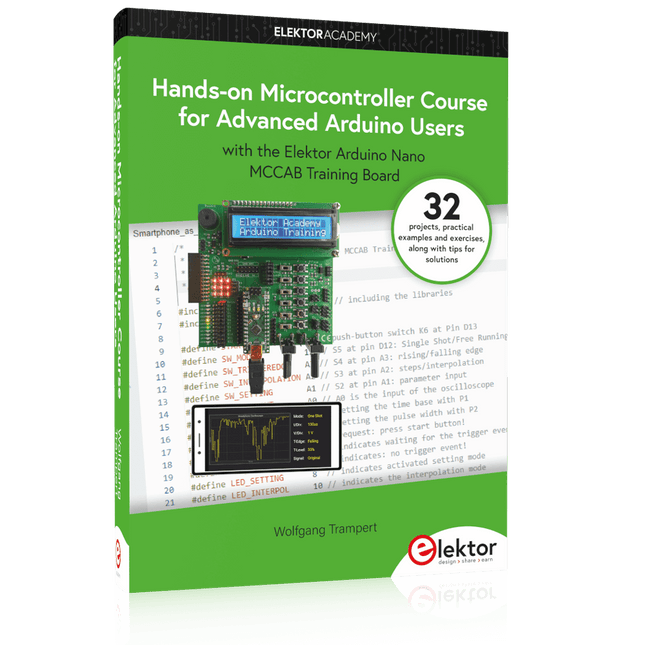
Elektor Publishing Hands-on Microcontroller Course for Advanced Arduino Users
32 new Projects, Practical Examples and Exercises with the Elektor Arduino Nano MCCAB Training Board Electronics and microcontroller technology offer the opportunity to be creative. This practical microcontroller course provides you with the chance to bring your own Arduino projects and experience such moments of success. Ideally, everything works as you imagined when you switch it on for the first time. In practice, however, things rarely work as expected. At that point, you need knowledge to efficiently search for and find the reason for the malfunction. In this book for advanced users, we delve deep into the world of microcontrollers and the Arduino IDE to learn new procedures and details, enabling you to successfully tackle and solve even more challenging situations. With this book, the author gives the reader the necessary tools to create projects independently and also to be able to find errors quickly. Instead of just offering ready-made solutions, he explains the background, the hardware used, and any tools required. He sets tasks in which the reader contributes their own creativity and writes the Arduino sketch themselves. If you don’t have a good idea and get stuck, there is, of course, a suggested solution for every project and every task, along with the corresponding software, which is commented on and explained in detail in the book. This practical course will teach you more about the inner workings of the Arduino Nano and its microcontroller. You will get to know hardware modules that you can use to realize new and interesting projects. You will familiarize yourself with software methods such as ‘state machines,’ which can often be used to solve problems more easily and clearly. The numerous practical projects and exercise sketches are once again realized on the Arduino Nano MCCAB Training Board, which you may already be familiar with from the course book ‘Microcontrollers Hands-on Course for Arduino Starters’, and which contains all the hardware peripherals and operating elements we need for the input/output operations of our sketches. Readers who do not yet own the Arduino Nano MCCAB Training Board can purchase the required hardware separately, or alternatively, build it on a breadboard.
€ 49,95
Membres € 44,96
-

Elektor Digital Hardware Projects for Raspberry Pi (E-book)
The Raspberry Pi is a $35 credit-card sized computer with many applications, such as in desktop computing, audio and video playback, and as a controller in many industrial, commercial and domestic applications. This book is about the Raspberry Pi computer and its use in control applications. The book explains in simple terms, with examples, how to configure the RPi, how to install and use the Linux operating system, how to write programs using the Python programming language and how to develop hardware based projects. The book starts with an introduction to the Raspberry Pi computer and covers the topics of purchasing all the necessary equipment and installing/using the Linux operating system in command mode. Use of the user-friendly graphical desktop operating environment is explained using example applications. The RPi network interface is explained in simple steps and demonstrates how the computer can be accessed remotely from a desktop or a laptop computer. The remaining parts of the book cover the Python programming language, hardware development tools, hardware interface details, and RPi based hardware projects. All the 23 projects given in the book have been tested and are working. The following headings are given for each project: Project title Project description Project block diagram Project circuit diagram Project program description using the Program Description Language (PDL) Complete program listing Description of the program The book is ideal for self-study, and is intended for electronic/electrical engineering students, practising engineers, research students, and hobbyists.
€ 34,95
Membres € 27,96
-
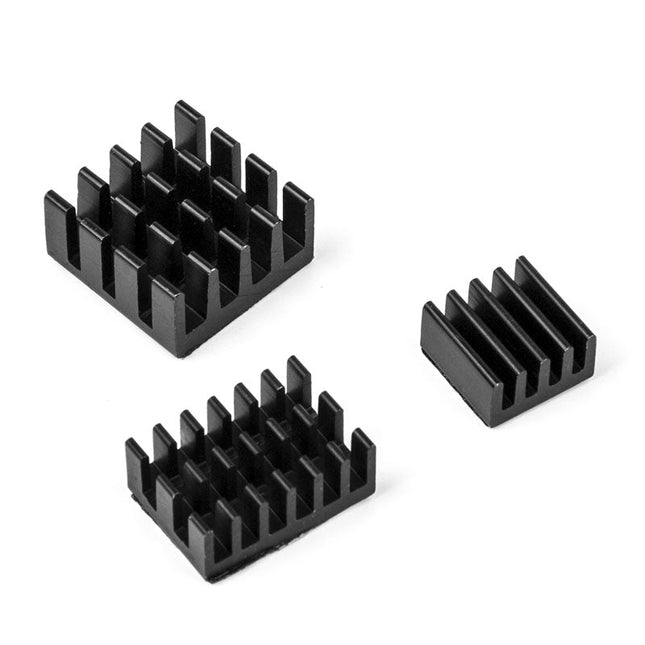
Kuongshun Kit de dissipateurs thermiques pour Raspberry Pi (noir)
Jeu de 3 dissipateurs thermiques en aluminium pour Raspberry Pi 4 en 5 Contenu 1x 14x14x6 mm 1x 15x10x5 mm 1x 8,8x8,8x5 mm
€ 3,95€ 2,95
Membres identique
-
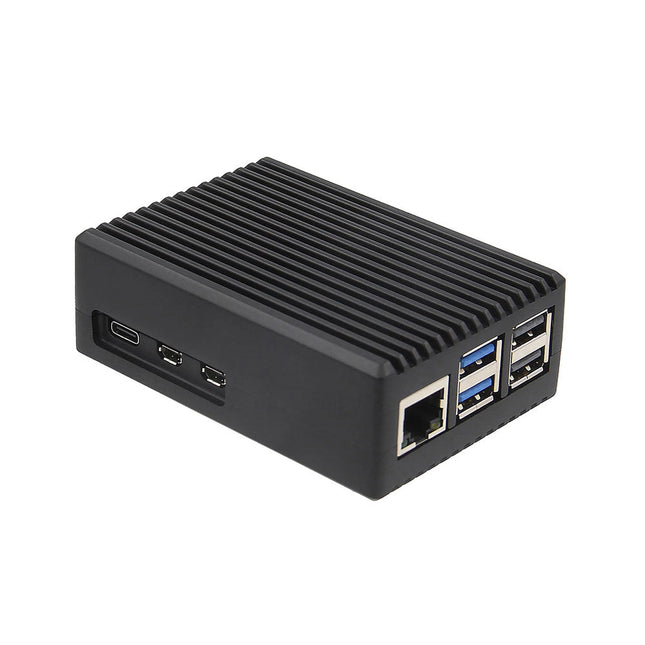
Generic Boîtier de refroidissement passif en aluminium robuste pour Raspberry Pi 5
Ce boîtier de refroidissement passif et robuste en aluminium est spécialement conçu pour le Raspberry Pi 5 et offre un design élégant qui garantit à la fois durabilité et dissipation efficace de la chaleur. Le boîtier est exclusivement compatible avec le Raspberry Pi 5 et fournit une solution de refroidissement passif, éliminant le besoin d'un ventilateur tout en gérant efficacement la chaleur. Caractéristiques Construction en aluminium de haute qualité : Fabriqué à partir d'aluminium de haute qualité, ce boîtier est conçu pour durer et résister à une utilisation régulière. Dissipation thermique optimisée : la conception de refroidissement passif utilise la structure en aluminium pour garder votre Raspberry Pi 5 au frais sans avoir besoin d'un ventilateur. Accessibilité totale des ports : chaque port du Raspberry Pi 5 est facilement accessible, depuis l'emplacement pour carte microSD jusqu'aux ports USB, micro HDMI et GPIO. Prise en charge du câble GPIO : Une interface réservée pour le câble GPIO garantit que vous pouvez continuer à utiliser cette fonction importante sans avoir à retirer le boîtier. Interrupteur d'alimentation pratique : le boîtier est doté d'un interrupteur d'alimentation intégré qui vous permet d'allumer et d'éteindre votre appareil.
€ 14,95
Membres € 13,46
-
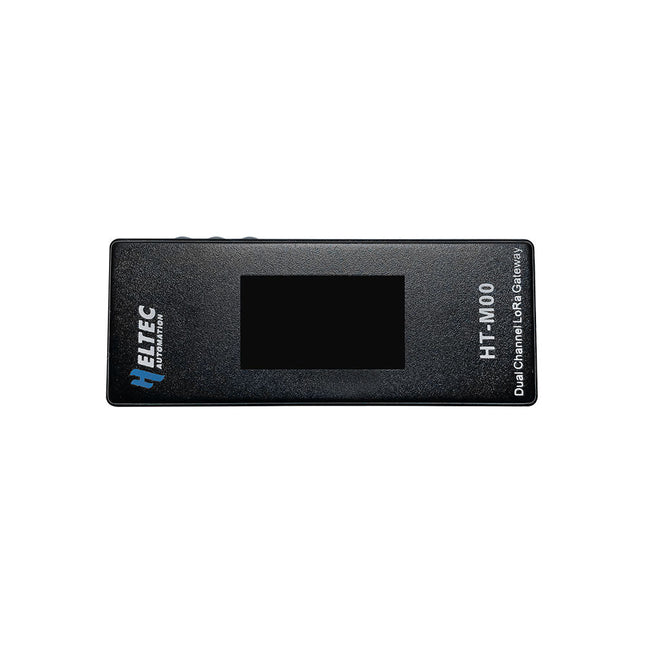
Heltec Automation Heltec HT-M00 Passerelle LoRa à 2 canaux (EU868)
Le HT-M00 est une passerelle double canal spécialement conçue pour répondre aux applications LoRa de la famille intelligente qui fonctionnent avec moins de 30 nœuds LoRa. La passerelle a été construite autour de deux puces SX1276 pilotées par ESP32. Pour permettre la surveillance du facteur d'étalement SF7~SF12 de 125 kHz, un mélangeur logiciel a été développé, communément appelé programme de simulation en bande de base. Le mélangeur logiciel est un composant essentiel qui permet à la passerelle HT-M00 de fonctionner avec une grande efficacité. Il est conçu pour simuler des signaux en bande de base, qui sont ensuite mélangés aux signaux radiofréquence pour produire le résultat souhaité. Le mélangeur logiciel a été développé avec beaucoup de soin et de précision, et a été soumis à des tests rigoureux pour garantir qu'il est capable de fournir des résultats précis et fiables. Caractéristiques ESP32 + SX1276 Émule les démodulateurs LoRa Le facteur d'étalement du spectre adaptatif automatique, SF7 à SF12 pour chaque canal, est facultatif Sortie maximale : 18 ±1 dBm Prise en charge du protocole LoRaWAN Classe A et Classe C Spécifications MCU ESP32-D0WDQ6 Jeu de puces LoRa SX1276 Bande LoRa 863~870 MHz Tension d'alimentation 5 V Sensibilité de réception -110 dBm à 300 bps Interface USB-C Max. Puissance d'émission 17dB ±1dB Température de fonctionnement −20~70°C Dimensions 30 x 76 x 14 mm Inclus 1x HT-M00 Passerelle LoRa à 2 canaux 1x Support mural 1x Câble USB-C Downloads Manual Software Documentation
€ 74,95€ 54,95
Membres identique
-
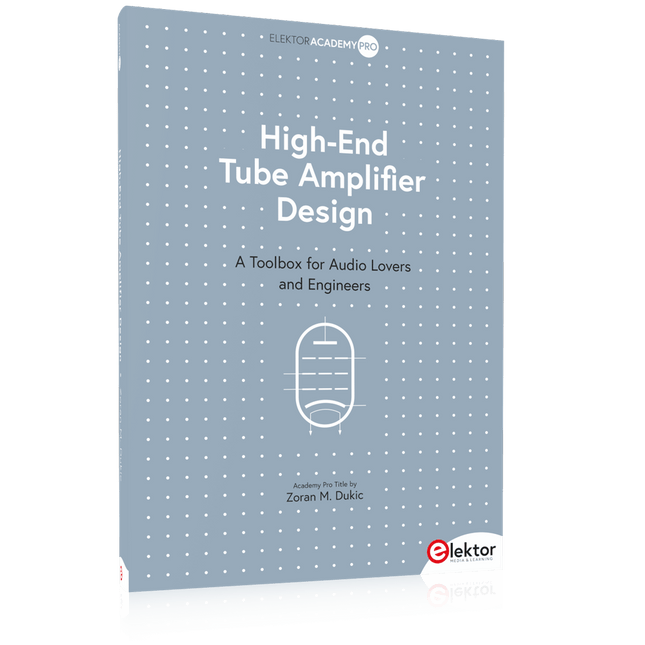
Elektor Publishing High-End Tube Amplifier Design
A Toolbox for Audio Lovers and Engineers Without any ambition to reach scientific levels, this book aims to be a toolbox for both audio lovers and high-end equipment designers. The elementary theory presented is the bare minimum for readers to grasp the operation and practical use of electrical, electromagnetic, physics, and electronic operations available in the designers’ toolbox. Each tool is explained in a minimum of words and theory without needless coverage of underlying equations or figures. The book chapters guide you through the process of designing quality amplifiers with vacuum tubes, from the very beginning, considering both technical and subjective requirements – in theory and practice. The book is a compilation of the author’s notes used in his professional and educational career but was nevertheless primarily written as a result of true love for the audiophile hobby.
€ 69,95€ 59,95
Membres identique
-
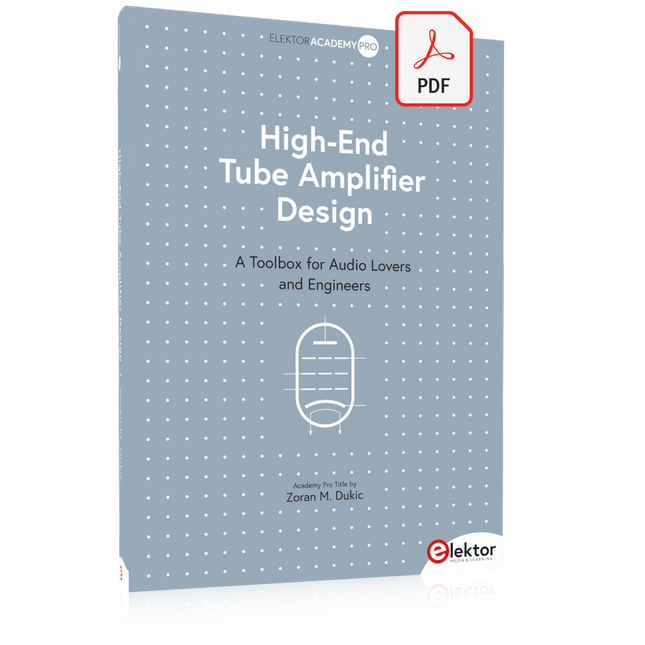
Elektor Digital High-End Tube Amplifier Design (E-book)
A Toolbox for Audio Lovers and Engineers Without any ambition to reach scientific levels, this book aims to be a toolbox for both audio lovers and high-end equipment designers. The elementary theory presented is the bare minimum for readers to grasp the operation and practical use of electrical, electromagnetic, physics, and electronic operations available in the designers’ toolbox. Each tool is explained in a minimum of words and theory without needless coverage of underlying equations or figures. The book chapters guide you through the process of designing quality amplifiers with vacuum tubes, from the very beginning, considering both technical and subjective requirements – in theory and practice. The book is a compilation of the author’s notes used in his professional and educational career but was nevertheless primarily written as a result of true love for the audiophile hobby.
€ 54,95
Membres € 43,96
-
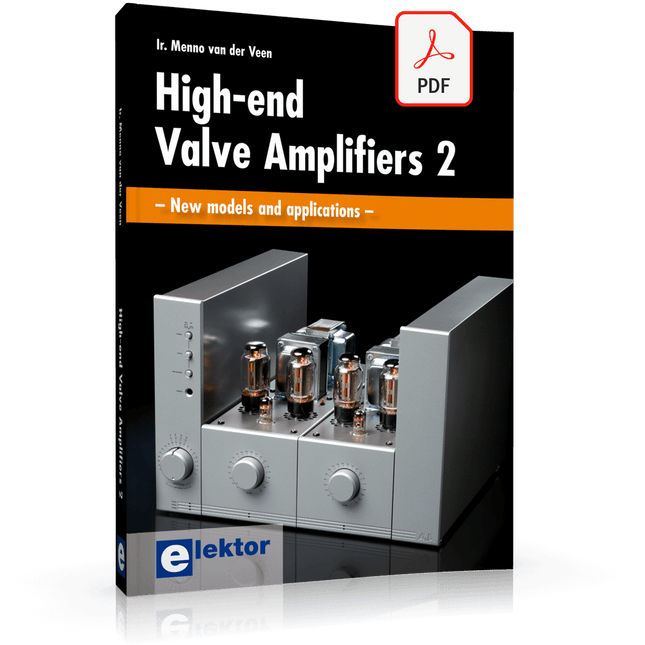
Elektor Digital High-End Valve Amplifiers 2 (E-book)
Nobody has any doubt that valve amplifiers produce a remarkably beautiful sound. They have a lively, deep, clear, and expressive sound, and dynamically they do not appear to have any limitations. The author investigates, in a systematic theoretical approach, the reasons for these beautiful properties. He develops new models for power valves and transformers, thus enabling the designer to determine the properties of the amplifier during the design process. Mathematical models for the coupling of power valve(s) and output transformer are provided. These will generate new insights in a special kind of distortion: the dynamic damping factor distortion (DDFD). With mathematical models in the complex domain, especially the properties at the limits of our hearing range (from 20 Hz to 20 kHz) are investigated and the minimal stability criteria for the amplifier are formulated. The often-applied negative feedback in amplifiers is extensively modelled and discussed in relation to our hearing appreciating. And after all this theory a fine selection of special amplifiers is presented and discussed. You will notice in this book that the author not only writes about amplifier technique, but tells about the way the development of valve amplifiers can have an influence on your daily life; even the usefulness of patents is discussed. Summarizing: new theories and solutions for perfect audio with valve amplifiers. Not only the professional and the DIY-er but everyone who wants to understand valve amplifiers will read this book with much pleasure.
€ 34,95
Membres € 27,96
-

Holybro Kit de drone Holybro QAV 250 ARF
Le kit QAV250 est le moyen idéal pour commencer à développer sur PX4 ou Ardupilot. Il associe un cadre de course 250 en fibre de carbone et des composants électroniques essentiels au mini pilote automatique Pixhawk 6C. Le kit est facile à assembler. Aucune soudure nécessaire. Spécifications Micromodule d'alimentation (PM06 v2) Moteurs : 2207 KV1950 Empattement : 250 mm Dimensions : 198 x 235 x 70 mm Poids : 347g Inclus Cellule 250 en fibre de carbone avec matériel Micromodule d'alimentation (PM06 v2) Moteurs : 2207 KV1950 Accessoires en plastique 5" Carte de gestion de l'alimentation entièrement assemblée avec ESC (BLHeli S ESC 20A) Sangles de batterie Remarque : la batterie LiPo n'est pas incluse.
€ 214,95
Membres identique
-

Holybro Kit de drone Holybro X500 V2 ARF
Le kit X500 V2 ARF est un kit de drone professionnel en fibre de carbone abordable, léger et robuste, facile à assembler (moins de 15 minutes). Il est livré avec le kit de cadre X500 V2 et les moteurs, ESC, tableaux de distribution d'énergie et hélices préinstallés. Il est parfaitement compatible avec divers contrôleurs de vol tels que la série Holybro Pixhawk, Durandal, Pix32 V5, etc. Il existe de nombreuses améliorations par rapport au modèle précédent. Spécifications Empattement : 500 mm Modèle de montage moteur : 16x16 mm Corps du cadre : 144x144 mm, 2 mm d'épaisseur Hauteur du train d'atterrissage : 215 mm Espace entre les plaques supérieure et inférieure : 28 mm Poids : 610g Temps de vol : environ 18 minutes de vol stationnaire sans charge utile supplémentaire. Testé avec une batterie de 5000 mAh. Charge utile : 1 500 g (sans batterie) Recommandation de batterie : 4S 3000-5000 mAh 20C+ avec batterie Lipo XT60 (non incluse) Inclus Kit cadre X500 V2 Avec les éléments préinstallés : 4x moteurs : moteur Holybro 2216 KV920 (4 pièces) avec prise XT30 4x ESC (BLHeli S ESC 20A) 6x 1045 hélices Carte de distribution d'énergie – Prise XT60 pour batterie et prise XT30 pour ESC et périphériques Remarque : le support de caméra de profondeur est vendu séparément.
€ 379,95
Membres identique
-
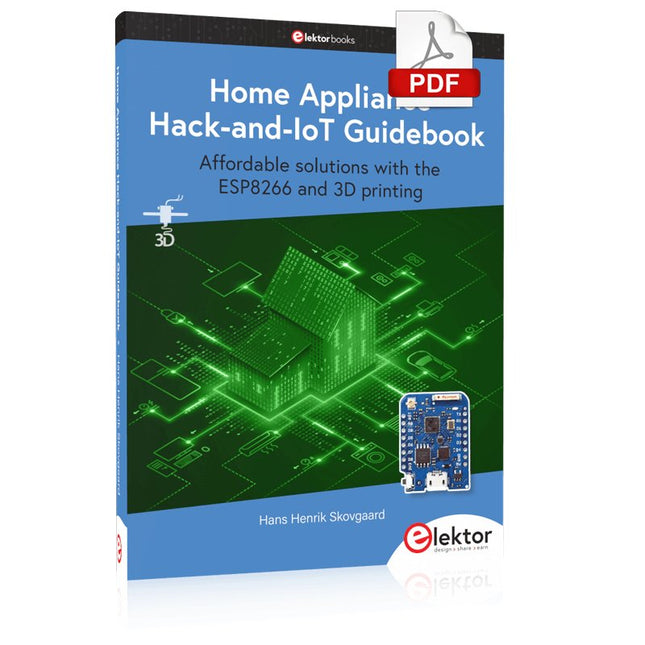
Elektor Digital Home Appliance Hack-and-IoT Guidebook (E-book)
Affordable solutions with the ESP8266 and 3D printing If you are looking for a small yet powerful IoT device, you are likely to come across the ESP8266 and compatible products on the market today. One of these, the Wemos/Lolin D1 Mini Pro board strikes a remarkable balance between cost and performance. A small and very affordable prototype board, the D1 Mini Pro stands out with its WiFi functionality and a 16-Mbytes flash memory for easy creation of a flash file system. In addition, there are sufficient input and output pins (only one analog input though) to support PWM, I²C, and One-Wire systems to mention but a few. The book describes the operation, modding, construction, and programming of home appliances including a colorful smart home accessory, a refrigerator/greenhouse controller, an AC powerline monitor, a door lock monitor, and an IKEA Trådfri controller. As a benefit, all firmware developed for these DIY, "IoT-ized" devices can be updated over-the-air (OTA). For most of the designs in the book, a small printed circuit board (PCB) and an enclosure are presented so readers can have a finished and attractive-looking product. Readers having – or with access to! – a 3D printer can "print" the suggested enclosures at home or in a shop. Some of the constructions benefit from a Raspberry Pi configured as a gateway or cms server. This is also described in detail with all the necessary configuring. You don’t need to be an expert but the prerequisites to successful replication of the projects include basic skills with PC software including the ability to surf the Internet. In terms of hardware, you should be comfortable with soldering and generally assembling the PCBs presented in the book. All custom software written for the IoT devices, the PCB layouts, and 3D print files described in the book are available for free downloading.
€ 34,95
Membres € 27,96
-
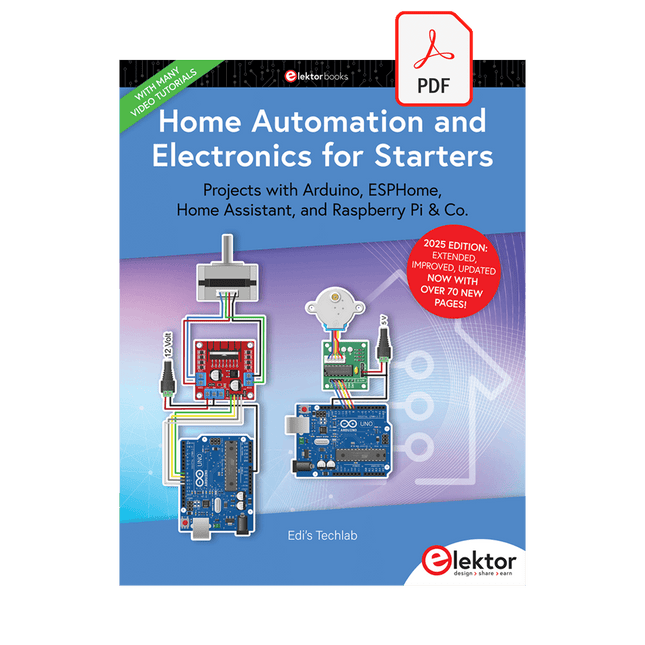
Elektor Digital Home Automation and Electronics for Starters (E-book)
Projets avec Arduino, ESPHome, Home Assistant, et Raspberry Pi & Co. Ce livre électronique contient plusieurs exemples de projets, en commençant par une introduction à l'électronique. Il explique également comment installer Home Assistant sur un Raspberry Pi, comment utiliser des capteurs de climat intérieur pour la température et l'humidité, comment mettre en œuvre le protocole MQTT et d'autres interfaces, et comment utiliser ESPHome pour intégrer des capteurs et des actionneurs dans Home Assistant. De nombreux tutoriels vidéo complètent le livre. Fundamentals of electrical engineering The book begins with an introduction to electrical engineering. You will learn the basics of voltage, current, resistors, diodes and transistors. Arduino and microcontrollers A complete section is dedicated to the Arduino Uno. You will get to know the structure, write your first programs and work on practical examples. Home Assistant and automation You will learn how to set up Home Assistant on a Raspberry Pi and how to use automations, scenes and devices. In addition, Zigbee, MQTT and ESP-NOW – important technologies for home automation – will be discussed. ESP8266, ESP32 and ESP32-CAM The popular ESP microcontrollers are covered in detail. A theoretical introduction is followed by practical projects that show you how to get the most out of these devices. Sensors and actuators The book explains the functionality and application of numerous sensors such as temperature and humidity sensors, motion detectors and RFID readers. For actuators, stepper motors, e-ink displays, servo motors and much more are covered. There are practical application examples for all devices. ESPHome This chapter shows you how to integrate sensors and actuators into Home Assistant without any programming effort. You will be guided step by step through the setup with ESPHome. LEDs and lighting technology In this chapter, you will learn about different types of LEDs and how they can be used. The basics of lighting technology are also explained. Node-RED A whole chapter is dedicated to Node-RED. You will learn the basics of this powerful tool and be guided step by step through its setup and use. Integrated Circuits (ICs) In electronics, there are numerous ICs that make our lives easier. You will get to know the most important ones and apply your knowledge in practical projects. Professional programming Advanced topics such as the correct use of buttons, the use of interrupts and the use of an NTP server for time synchronisation are covered in detail in this chapter. Downloads GitHub
€ 49,95€ 39,95
Membres identique
-

Elektor Digital Home Automation Projects with Arduino (E-book)
Using the RFID Starter Kit An Arduino board has now become ‘the’ basic component in the maker community. No longer is an introduction to the world of microcontrollers the preserve of the expert. When it comes to expanding the capabilities of the basic Arduino board however, the developer is still largely on his own. If you really want to build some innovative projects it’s often necessary to get down to component level. This can present many beginners with major problems. That is exactly where this book begins. This book explains how a wide variety of practical projects can be built using items supplied in a single kit together with the Arduino board. This kit, called the 'RFID Starter Kit for Arduino' (SKU 17240) is not just limited to RFID applications but contains more than 30 components, devices and modules covering all areas of modern electronics. In addition to more simple components such as LEDs and resistors there are also complex and sophisticated modules that employ the latest technology such as: A humidity sensor A multicolor LED A large LED matrix with 64 points of light A 4-character 7-segment LED display An infra red remote-controller unit A complete LC-display module A servo A stepper motor and controller module A complete RFID reader module and security tag On top of that you will get to build precise digital thermometers, hygrometers, exposure meters and various alarm systems. There are also practical devices and applications such as a fully automatic rain sensor, a sound-controlled remote control system, a multifunctional weather station and so much more. All of the projects described can be built using the components supplied in the Elektor kit.
€ 29,95
Membres € 23,96
-
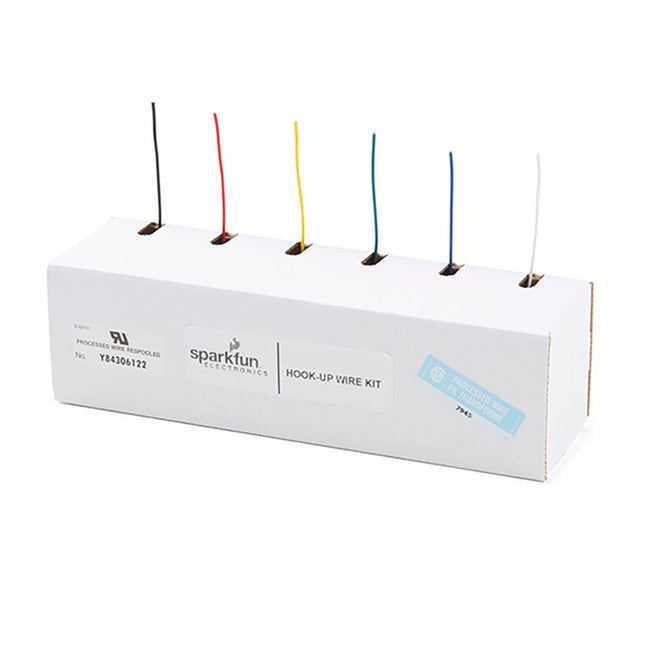
SparkFun Hook-Up Wire – Assortment (Solid Core, 22 AWG)
Un assortiment de fils colorés : vous savez bien que c’est une très belle chose. Six couleurs différentes de fil torsadé dans une boîte de distribution en carton. Asseyez-vous à votre banc de travail, et arrêtez de vous inquiéter d’avoir des morceaux de fil tout autour de vous! Inclus dans le kit : 22 AWG 25 pi / Bobine 6 bobines en six couleurs différentes Couleurs : rouge, bleu, jaune, vert, noir et blanc Boîte de distribution
€ 31,95
Membres € 28,76
-
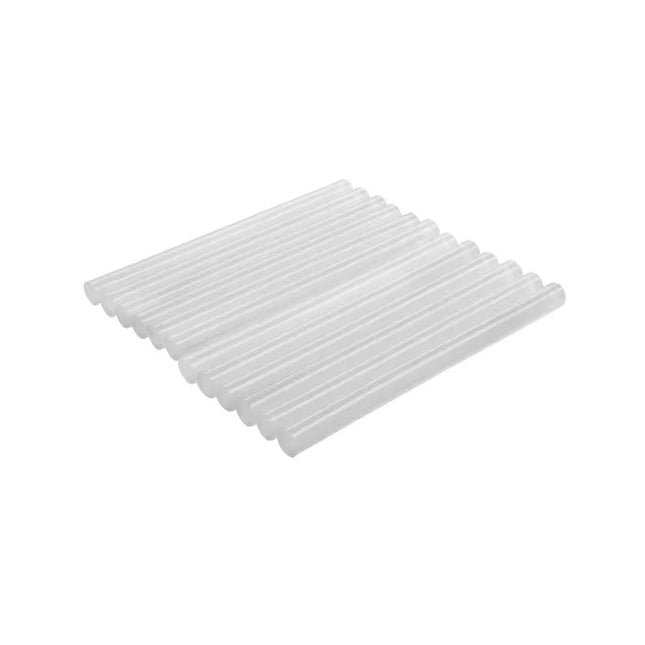
Zhongdi Bâtons de colle chaude (100 mm, 12 pièces)
Ces bâtons de colle chaude de 10 cm de long sont compatibles avec tous les pistolets à colle chaude courants d'un diamètre de 7,2 mm.
€ 2,95€ 0,95
Membres identique
-

Elektor Publishing How Humanity Turned Electricity into Electronics
From Rubbing Amber to Swiping Glass "The story of electricity, told one connection at a time."Why does rubbing amber attract dust? How did we go from that curious effect to a world where screens respond to a single touch? And how did we get from mysterious sparks to tiny chips packed with billions of transistors? For centuries, electricity puzzled and fascinated those who encountered its curious effects—long before it even had a name. From the earliest observations of static charge to the complex electronics that shape our lives today, this book traces the gradual, and often surprising, story of how humanity came to understand and harness this powerful force. This book offers an engaging and accessible account of the people, ideas, and inventions that transformed electricity from a scientific curiosity into the foundation of our digital age. Along the way, you’ll meet a host of inquisitive minds—some famous, others less so—whose persistence and creativity helped unravel the mysteries of the natural world and gave rise to the technologies we now take for granted. Covering everything from Leyden jars and batteries to transistors, microcontrollers and the internet, this book presents a clear and enjoyable overview of electronics and its relatively short, yet rich, history. Whether you have a technical background or simply a curiosity about how things work, From Rubbing Amber to Swiping Glass offers a thoughtful look at how far we’ve come—and a gentle nudge to wonder what might come next.
€ 39,95€ 32,95
Membres identique
-
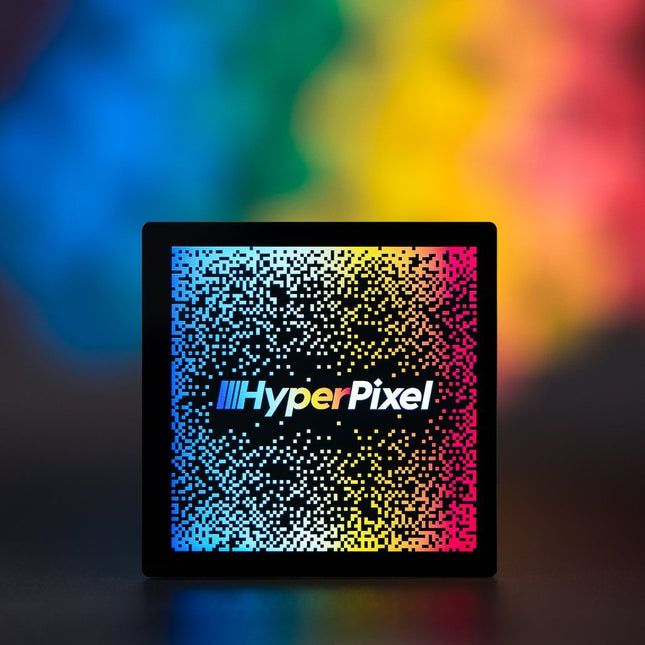
Pimoroni HyperPixel 4.0 Square Touch – Écran haute résolution pour Raspberry Pi
HyperPixel 4.0 Square possède toutes les fonctionnalités exceptionnelles de notre HyperPixel 4.0 standard : un écran IPS net et brillant avec écran tactile et une interface DPI haute vitesse ; il est tout simplement plus carré ! Cette version carrée d'HyperPixel 4.0 est idéale pour les interfaces et panneaux de contrôle personnalisés, et fonctionne très bien pour les jeux Pico-8. Tout est pré-soudé et prêt à l'emploi, il suffit de l'insérer sur votre RPi, d'exécuter notre programme d'installation, et c'est parti ! Caractéristiques Interface DPI haute vitesse Écran IPS 4,0' (grand angle de vision, 160°) (72 x 72 mm) 720 x 720 pixels (~ 254 PPI) Couleur 18 bits (262 144 couleurs) Fréquence d'images de 60 FPS Écran tactile capacitif en option Connecteur femelle à 40 broches inclus pour augmenter la hauteur des Raspberry Pi B+, 2, 3, 3B+ et 4 Entretoises incluses pour attacher solidement à votre RPi Compatible avec tous les modèles Raspberry Pi à connecteur 40 broches Installateur sur une seule ligne HyperPixel 4.0 Square utilise une interface DPI haute vitesse, lui permettant de déplacer 5 fois plus de données de pixels que l'interface SPI habituelle que ces petits écrans RPi utilisent normalement. Il a une fréquence d'images de 60 FPS et une résolution d'environ 254 pixels par pouce (720 x 720 px) sur son écran de 4,0 pouces. L'écran peut afficher 18 bits de couleur (262 144 couleurs). Cette version Touch dispose d'un écran tactile capacitif qui est plus sensible et réactif au toucher qu'un écran tactile résistif, et elle est capable de multi-touch ! Attention : lors de l'installation de HyperPixel 4.0 Square sur votre RPi, veillez à ne pas appuyer sur la surface de l'écran ! Tenez la carte par ses bords et remuez-la pour l'accoupler à l'en-tête étendu (ou à l'en-tête GPIO). Veillez également à ne pas tirer sur les bords de l'écran en verre lorsque vous retirez votre HyperPixel. Il fonctionnera avec n'importe quelle version à 40 broches du RPi, y compris le RPi Zero et le RPi Zero W. Si vous l'utilisez avec un RPi plus grand, utilisez l'en-tête supplémentaire à 40 broches inclus pour l'augmenter jusqu'à la hauteur requise. . Si vous utilisez un Zero ou Zero W, insérez-le simplement directement sur le GPIO. Le kit d'entretoise inclus vous permet de monter votre HyperPixel 4.0 Square en toute sécurité sur votre RPi. Vissez-les simplement dans les poteaux situés sous le PCB carré HyperPixel 4.0, puis fixez-les avec des vis à travers les trous de montage de votre RPi. Téléchargements GitHub
€ 84,95€ 64,95
Membres identique
-
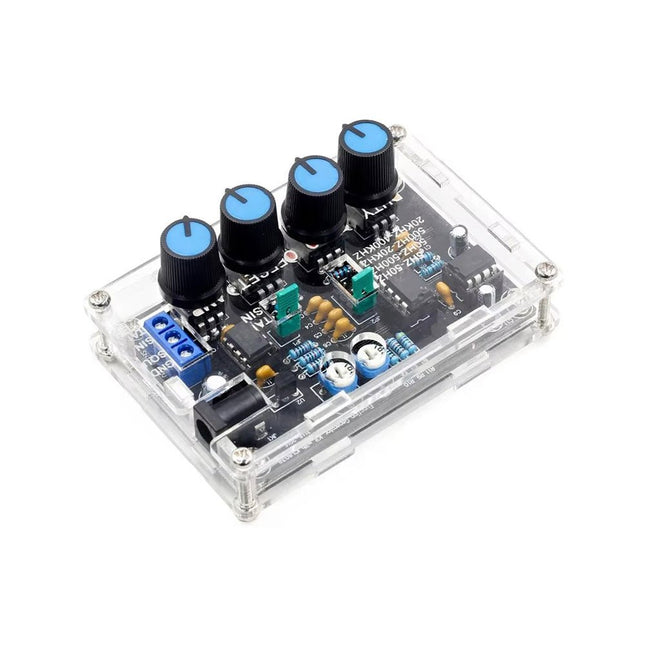
Generic ICL8038 Kit de générateur de signaux DIY (5 Hz – 400 kHz)
Le générateur de signaux ICL8038 fournit des formes d'onde polyvalentes, notamment sinusoïdales, triangulaires, carrées et en dents de scie avant/arrière, ce qui le rend adapté à une large gamme d'applications. Alimenté par la puce ICL8038 et des amplificateurs opérationnels à grande vitesse, il garantit une précision et une stabilité du signal exceptionnelles. Avec une plage de fréquences de 5 Hz à 400 kHz, il prend en charge les applications allant de l'audio aux fréquences radio. Son cycle de service réglable, allant de 2% à 95%, permet une personnalisation précise de la forme d'onde pour répondre à divers besoins. Le kit DIY est adapté aux débutants et comprend des composants traversants pour un assemblage facile. Il comprend toutes les pièces nécessaires, une coque en acrylique et un manuel détaillé, fournissant tout le nécessaire pour construire et utiliser efficacement le générateur de signaux. Spécifications Plage de fréquence 5 Hz~400 KHz (réglable) Tension d'alimentation 12 V~15 V Plage de cycles de service 2%~95% (réglable) Onde sinusoïdale à faible distorsion 1% Dérive à basse température 50 ppm/°C Linéarité de l'onde triangulaire de sortie 0,1% Plage de polarisation CC −7,5 V~7,5 V Plage d'amplitude de sortie 0,1 V~11 VPP (tension de fonctionnement 12 V) Dimensions 89 x 60 x 35 mm Poids 81 g Inclus PCB inclus. tous les composants nécessaires Boîtier en acrylique Manuel
€ 14,95€ 7,95
Membres identique
-
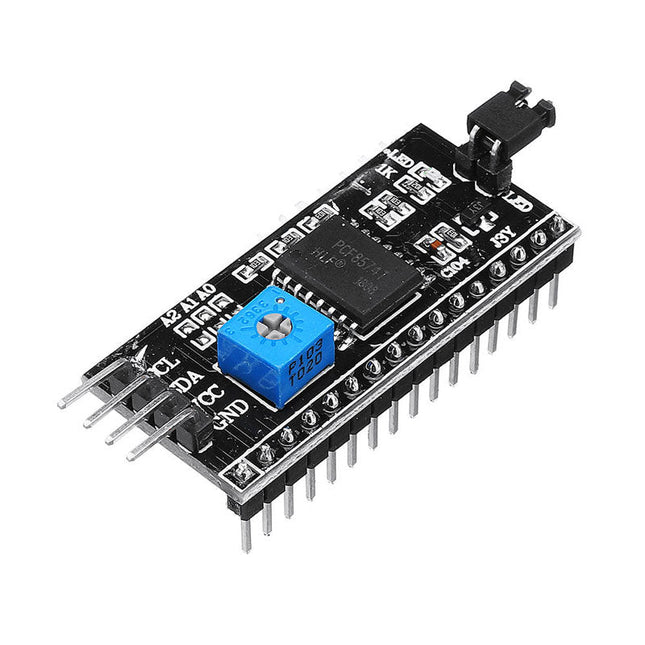
Kuongshun Module adaptateur d'interface série IIC/I²C
Il s'agit d'une autre excellente interface série IIC/I²C/TWI/SPI. Comme les ressources en broches du contrôleur sont limitées, votre projet risque de ne pas pouvoir utiliser le blindage LCD normal après avoir été connecté à une certaine quantité de capteurs ou de carte SD. Cependant, avec ce module d'interface I²C, vous pourrez réaliser l'affichage des données via seulement 2 fils. Si vous avez déjà des appareils I²C dans votre projet, ce module LCD ne coûte en réalité aucune ressource supplémentaire. C'est fantastique pour un projet basé. Adresse I²C : 0X20~0X27 (l'adresse d'origine est 0X20, vous pouvez la modifier vous-même) Le rétroéclairage et le contraste sont ajustés par potentiomètre Livré avec 2 interfaces IIC, qui peuvent être connectées par Dupont Line ou un câble dédié IIC Adresse I²C : 0x27 (Adresse I²C : 0X20~0X27 (l'adresse d'origine est 0X27, vous pouvez la modifier vous-même) Caractéristiques Compatible pour 1602 LCD Tension d'alimentation : 5 V Poids : 5g Taille: 5,5 x 2,3 x 1,4 cm
€ 4,95
Membres € 4,46
-
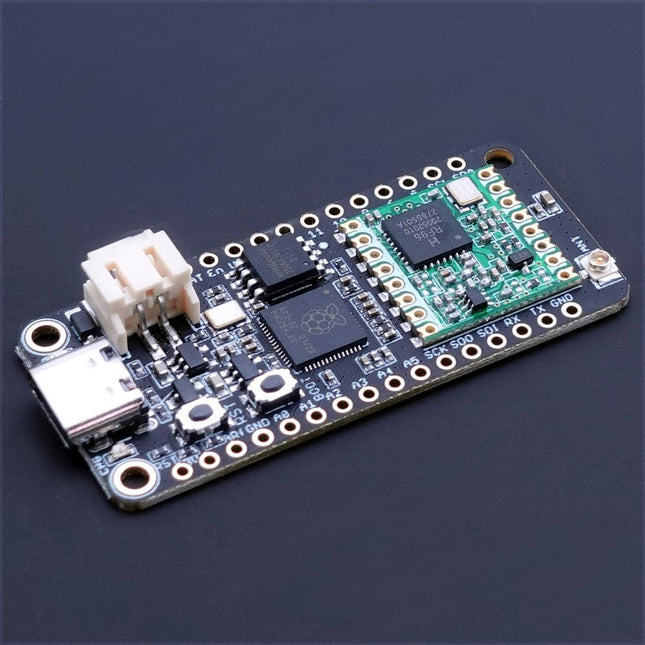
iLabs iLabs Challenger RP2040 LoRa (EU868)
Le Challenger RP2040 LoRa est une carte de microcontrôleur Adafruit Feather compatible Arduino/CircuitPython basée sur la puce Raspberry Pi Pico (RP2040). L'émetteur-récepteur est doté d'un modem LoRa à longue portée qui fournit une communication à spectre étalé à très longue portée et une immunité élevée aux interférences tout en minimisant la consommation de courant. LoRa Le module LoRa intégré (RFM95W) peut atteindre une sensibilité de plus de -148 dBm en utilisant un cristal et quelques composants. La sensibilité élevée combinée à l'amplificateur de puissance intégré de +20 dBm permet d'obtenir un budget de liaison de premier ordre, ce qui le rend optimal pour toute application nécessitant de la portée ou de la robustesse. LoRa offre également des avantages significatifs en termes de blocage et de sélectivité par rapport aux techniques de modulation conventionnelles, résolvant ainsi le compromis traditionnel de conception entre la portée, l'immunité aux interférences et la consommation d'énergie. Le RFM95W est connecté au RP2040 via le canal SPI 1 plus quelques ports GPIO nécessaires à la signalisation. Un connecteur U.FL est utilisé pour attacher votre antenne LoRa à la carte. 168 dB de budget de liaison maximum +20 dBm - 100 mW de sortie RF constante par rapport à la tension d'alimentation PA à haut rendement de +14 dBm Débit binaire programmable jusqu'à 300 kbps Haute sensibilité : jusqu'à -148 dBm IIP3 récepteur/émetteur : -12,5 dBm Excellente immunité de blocage Faible courant RX de 10,3 mA, rétention de registre de 200 nA Synthétiseur entièrement intégré avec une résolution de 61 Hz FSK, GFSK, MSK, GMSK, LoRaTM et modulation OOK Synchronisateur de bits intégré pour la récupération de l'horloge Détection de préambule Plage dynamique de 127 dB RSSI Détection RF automatique et CAD avec AFC ultra-rapide Moteur de paquets jusqu'à 256 octets avec CRC Spécifications Microcontrôleur Raspberry Pi RP2040 (Cortex-M0+ double cœur 133 MHz) SPI Deux canaux SPI (deuxième SPI connecté au RFM95W) I²C Un canal I²C UART Un canal UART Entrées analogiques 4 entrées analogiques Module radio RFM95W de Hope RF Mémoire flash 8 Mo, 133 MHz Mémoire SRAM 264 Ko (répartis en 6 banques) Contrôleur USB 2.0 Jusqu'à 12 MBit/s à pleine vitesse (PHY USB 1.1 intégré) Connecteur de batterie JST Pas de 2,0 mm Chargeur LiPo embarqué 450 mA courant de charge standard Dimensions 51 x 23 x 3,2 mm Poids 9 g Téléchargements Fiche technique Dossier de conception
€ 24,95
Membres € 22,46
-
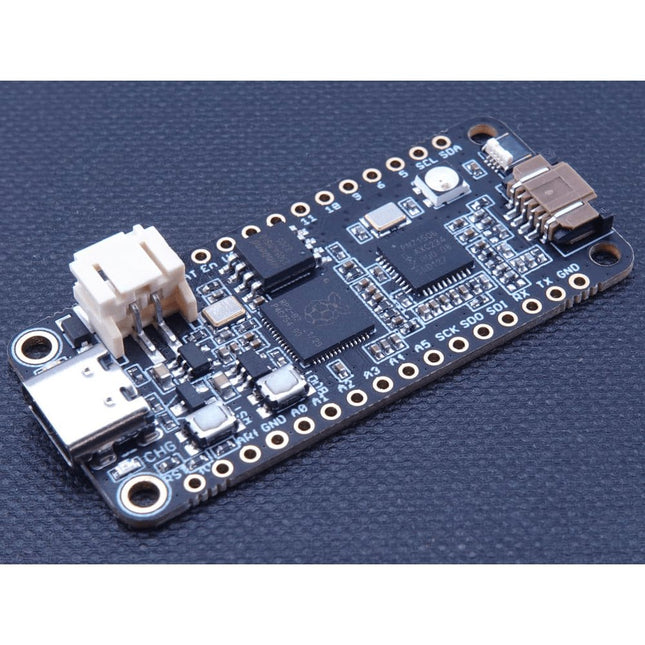
iLabs iLabs Challenger RP2040 NFC
Le Challenger RP2040 NFC est un petit ordinateur embarqué, équipé d'un contrôleur NFC intégré avancé (NXP PN7150), dans le format populaire Adafruit Feather. Il est basé sur une puce de microcontrôleur RP2040 de la Fondation Raspberry Pi qui est un Cortex-M0 double cœur pouvant fonctionner sur une horloge allant jusqu'à 133 MHz. NFC Le PN7150 est une solution de contrôleur NFC complète avec micrologiciel intégré et interface NCI conçue pour une communication sans contact à 13,56 MHz. Il est entièrement compatible avec les exigences du forum NFC et est largement conçu sur la base des enseignements tirés de la génération précédente d'appareils NXP NFC. C'est la solution idéale pour intégrer rapidement la technologie NFC dans n'importe quelle application, en particulier les petits systèmes embarqués réduisant la nomenclature (BOM). La conception intégrée avec une compatibilité totale avec le forum NFC offre à l'utilisateur toutes les fonctionnalités suivantes : Micrologiciel NFC intégré fournissant tous les protocoles NFC en tant que fonctionnalité pré-intégrée. Connexion directe à l'hôte principal ou au microcontrôleur, par bus physique I²C et protocole NCI. Consommation d'énergie ultra faible en mode boucle d'interrogation. Unité de gestion de l'énergie (PMU) intégrée très efficace permettant une alimentation directe à partir d'une batterie. Caractéristiques Microcontrôleur RP2040 de Raspberry Pi (Cortex-M0 double cœur 133 MHz) IPS Un canal SPI configuré I²C Deux canaux I²C configurés (I²C dédié pour le PN7150) UART Un canal UART configuré Entrées analogiques 4 canaux d'entrée analogiques Module NFC PN7150 de NXP Mémoire flash 8 Mo, 133 MHz Mémoire SRAM 264 Ko (divisé en 6 banques) Contrôleur USB 2.0 Jusqu'à 12 Mbit/s à pleine vitesse (USB 1.1 PHY intégré) Connecteur de batterie JST Pas de 2,0 mm Chargeur LiPo intégré Courant de charge standard de 450 mA Dimensions 51x23x3.2mm Poids 9g Remarque : l'antenne n'est pas incluse. Téléchargements Fiche de données Exemple de démarrage rapide
€ 22,95
Membres € 20,66























